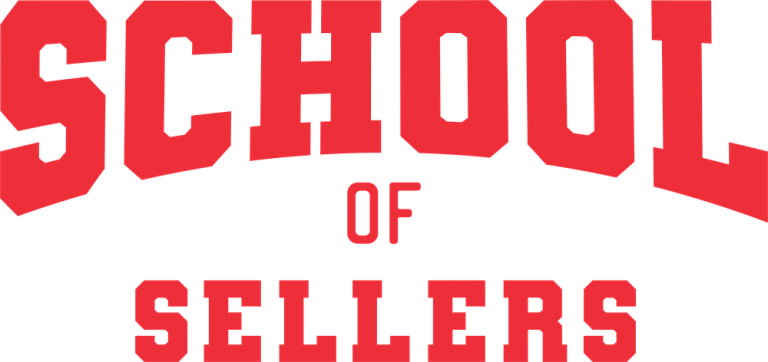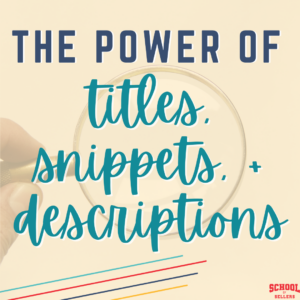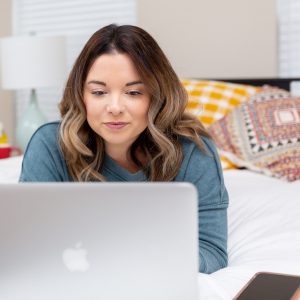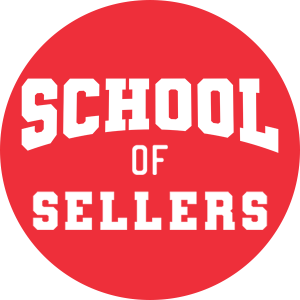Episode Summary
If you’ve ever wondered how to make TpT products that will actually sell in a market that seems so crowded, this is the show for you. Guest Kristen Doyle and I talk about 3 big ideas beyond the techy step-by-step of product creation. Anyone can create a product. Listen in to our top tips for making TeachersPayTeachers products that will maximize your success!
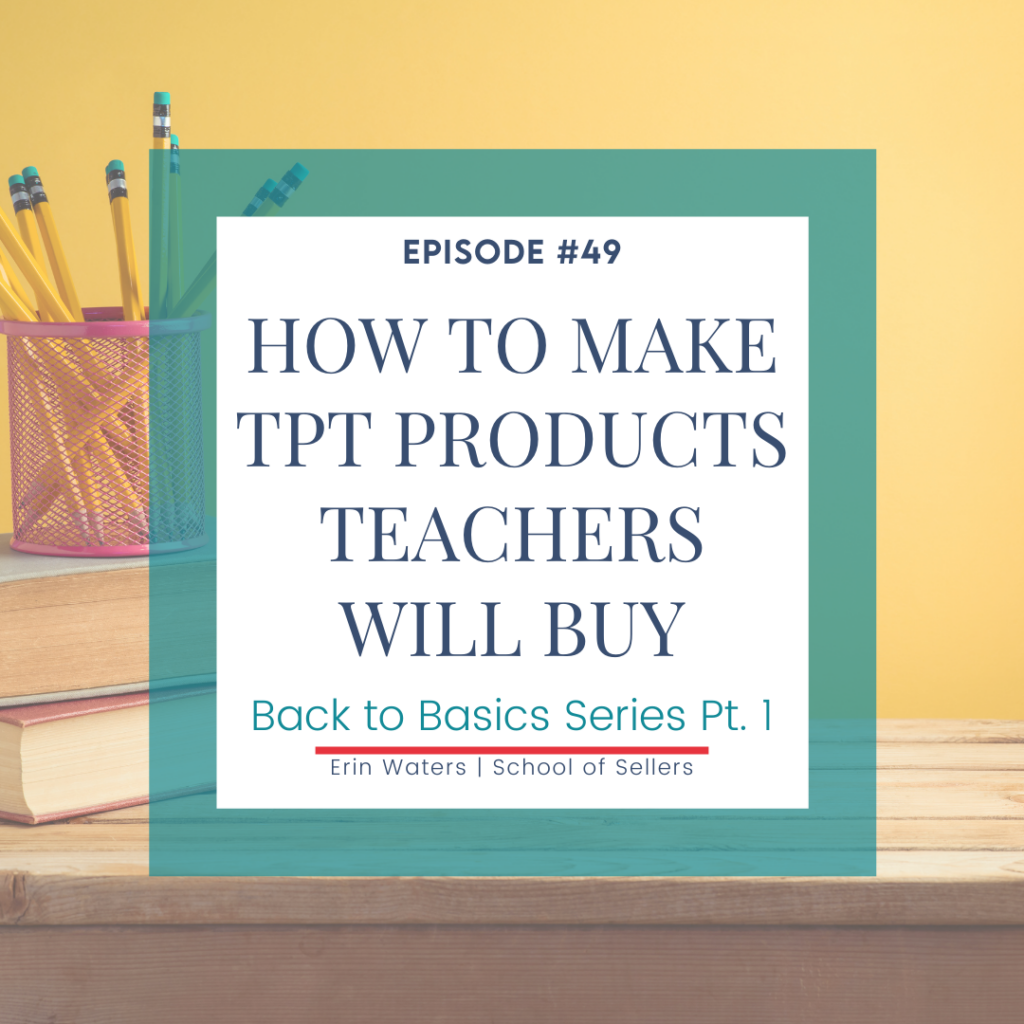
This post may contain affiliate links. As an Amazon Associate, I earn from qualifying purchases.
Introduction to How to Make TpT Products Teachers Will Buy
Erin Waters: Today marks the very beginning of our Back to Basics series here on the podcast. And I think probably all sellers, whether you’ve been around for a year or eight years like myself, can relate when I say that I am always learning new things about this business.
To kick it off, I have a very special guest, Kristen Doyle, who is one of my teacher seller friends. And today we are going to be talking about how to make TpT products for your store that people are actually going to buy. We are talking beyond just the obvious here’s how you make a slide and here’s how you input fonts. All of those things will be taught in the foundations course for new TpT sellers that we are releasing in May of 2021. But today, Kristen’s going to talk with me about a lot of different things that are often overlooked in the product creation phase of TpT. So without further ado, I’d love to introduce you to Kristen.
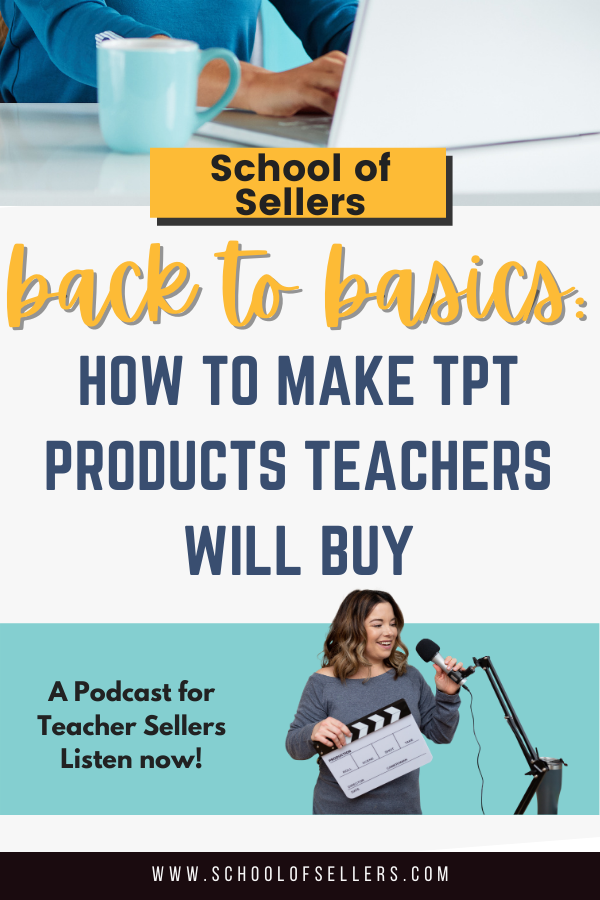

Kristen Doyle: Sure. I am Kristen Doyle. My TpT store is Chalk and Apples. And I have been on TpT almost nine years. I started in 2012 which I think is maybe when half the world started on TpT. It seems like everybody throws that number out. I’ve been on TpT for about nine years, and I’ve branched out and I’m doing WordPress designs and offer a course on SEO for teacher authors. So that has been a lot of fun. I love working with teacher authors and helping you guys grow your business. And I am now a homeschool mama. So that is a challenge. It has been a big shift. Sometimes I am not content with being settled and having things be easy and I always have to shake it up and add something new.
Erin Waters: You and I have both grown our secondary businesses quite a bit too since the pandemic, which has been really fun to see. I am currently enrolled in your course for SEO, Kristen, and I’m very excited about it. Because I always say in my School of Sellers community, like I am not an expert on anything. I just kind of share my mistakes and go from there. But you are very much the SEO expert.
You’re Selling a Solution to a Problem, Not a TpT Product
The reason I am so excited to talk to you today is because School of Sellers is coming out with a course for beginner TpT sellers, or even people who have a store but haven’t done much with it. The first thing that always comes to mind when people think TpT is obviously the products. Most of us get into TpT because we’re buying TpT products and then we slowly morph into the people who create them. And I think that product creation kind of gets an interesting reputation because we think it’s one thing but it’s actually so much more. In our Foundations course, we’re going to teach the on-screen stuff and all the technical stuff, like getting into PowerPoint.
But today I wanted to talk about the things that people don’t think about when it comes to TpT product creation. The first thing we’re going to talk about is something we’ve talked about on our Clubhouse Store Audits By the way, you can tune into those on Tuesday afternoons at 5:00 pm Eastern Time. The feedback we give people on those audits is that when you are selling your product, you don’t want to just sell your product. You want to sell the solution that you are offering teachers.
I think so often we think of products just as products and not so much as what they’re actually going to do for the teachers once they’re in that situation in their classroom, and I think this is tied to the search process. I always tell people to put yourself in a teacher’s mind when they are searching for something on TpT. What types of things are they going to be searching for and what types of things are they not going to be searching for when it comes to the language that we use?
Kristen Doyle: It’s important for us to remember it’s easy as a business owner to get so bogged down in creating the product that you think of it as the product that it is. But teachers don’t come to TpT looking for a product. They come to TpT looking for a solution to whatever their problem is. Maybe their problem is their students are not getting multiplication or they really need good reading centers and they do not have time for prepping a whole bunch of crazy parts and pieces. They come with a problem and they want us to be that solution. So it’s really important to be thinking of your products that way through the whole product creation process, and then definitely when you start talking about your product listing.
Keep It Simple When You Make TpT Products
Erin Waters: I think that a lot of times with newer sellers, they think there’s so many sellers already, there’s nothing new to create. I have to create like the newest, biggest, and best thing. A lot of times we lose sight of the fact that you have to really just keep it simple. If you’re searching for your next product idea, a lot of times just keeping it simple and thinking about what works in your classroom is the ticket.
Kristen Doyle: Because if you need it as a teacher, someone else needs it too. Probably a lot of someone else’s.
Erin Waters: Absolutely. A lot of my best sellers are things that really came in handy for me and now are probably finding their home in other classrooms too. You want to spark emotion in your buyers when they come across your product on TpT. So I think that’s the best place to start. Start in your own classroom. There’s no need to recreate the wheel. Just see what’s already working for you and share it with other teachers.
What kinds of TpT products should you create?
Erin Waters: And I think that leads perfectly into our second point. When you are creating your product, isn’t it so easy to see what other people are doing and just go with their ideas? Like you see task cards and we’re like, yes, I’m going to create task cards. So I think the second big point for product creation is not always going with your very first idea.
Kristen Doyle: It’s super tempting too when we see things that seem really popular to create similar stuff because we want our stuff to be popular too and we want to drive those sales. I’m sure you’ve heard the analogy of the blue ocean. You start pouring yourself into the red ocean where there’s just so much competition and so many things that are so similar. But you really can stand out more if you do your own thing and you create the products that no one else is creating.
Erin Waters: Absolutely. And I love that analogy because in order to be a seller in today’s world, you have to be swimming over to that blue ocean. You can’t expect to get that success by creating the exact same stuff that’s already out there.
Kristen Doyle: Because there is too much competition for that stuff. But there’s not as long as you make yourself stand out.
Create TpT Products That Are Unique in Some Way
Erin Waters: I totally agree. And I don’t think that we necessarily have to be creating brand new things every single time. I think it’s Marie Forleo who says that everything is a remix. Like really nothing out there is like super-duper 100% original. If you’re struggling to really find that “blue ocean,” you can also think about the ways that your product is delivered or packaged. So even if it’s a similar concept to stuff that’s already out there. For example, let’s just use task cards. Maybe you think about ways that they’re not out there yet. Maybe you want to turn them into boom cards or digitally change them into something. I don’t know. I’m just throwing ideas out there. But you can really get creative.
Kristen Doyle: Something that’s different, something that makes your task cards unique and not just like everybody else’s. I’ll just use task cards as an example, I’m in the upper elementary niche. Who’s the task card person? Rachel Lynette. She’s got a million task cards, and they’re all fabulous. But it’s really hard for a brand new seller to compete with someone who has such a following in a very specific product line, very specific area. But if we branch out and come up with our own unique spin on it, that’s where you can start to stand out and build your own following and have those buyers who come back to you instead because they like your version.
Erin Waters: That’s such a good point, and I think that’s very common. I remember starting out on TpT and all I wanted to do was make things that I already saw getting success. You think you have to do what everyone else is doing in order to get there. That’s where it’s really valuable to share our insight on the other side. We’ve been there and can look back and see what actually worked versus what our first instinct is.
I like telling new sellers to pretend you have a magic wand. Just take your first idea. Let’s say it’s task cards, but you’re going to wave your wand and think, task cards but make it digital. And then you have digital task cards. You’re like, okay, digital task cards but then let’s take it a step further. Let’s make them accessible on iPads, whatever. You just keep taking it further until finally you’re like, okay, I have something that seems unique enough to roll with. Never just the first idea. It’s usually the start of something good, but you have to take it a little further and add more value.
Revisit Your Old TpT Products and Focus on the TpT Listing
Erin Waters: Something that is totally overlooked in the product world is to keep adding things to your existing products that are going to make them stand out. Once we’re done, we’re just like, alright good, we won’t see you again in a few years. But those updates are just as important as the original product.
I can’t tell you how many times, even after eight years, I’m creating a product, it’s all created, and then I feel like I’m done. But then I have to sit down and actually list the product. I have to post it on TpT, put up all the thumbnails, the description, and everything. And for so long, I treated that process as an afterthought and that was such a mistake. Kristen, this is where you are just like my go-to person when it comes to listing your products. Do you see this often where people don’t really put that much significance on the listing process? And tell us how that can impact your business.
Kristen Doyle: I see that all the time. And I’ve been there too. I don’t know how many times in previous years I have been sitting at the computer at night and I get my brand new product all finished. It’s all pretty, preview is done, and my husband is waiting for me to not be on the computer anymore. I’m saying, oh, I just finished. I’m just going to list it on TpT and I’ll be right there. And two hours later, he’s asking me when I’m coming to bed.
But the product listing is—it’s hard to put a value on which part is most important. Obviously, you have to have a great product. But the way that you present it on your product listing on TpT is what is going to sell what’s inside that product. They can’t see the inside aside from whatever you show in the preview. So choosing those images well, making a good preview, and then having a really good product title and description are just so important for getting people to ever even really look at your product in order to convince them that they need to buy it.
Erin Waters: One of the things I love about the way that you explain the listing process is by comparing them to real life scenarios. When you talk about being able to find products and making sure that they’re actually ones that people come across in search listings, I think of Walmart. If you don’t pay attention to your listing, then it’s the equivalent of having this new product you’re really excited to put on the shelf, but you put it on the very bottom shelf and you push it all the way to the back where no one is ever going to see it. That’s great that you made it, and the product is still important and could solve problems for so many teachers, but no one’s going to find it if you don’t list it the right way.
Kristen Doyle: Exactly. You have to package it up well and list it the right way. That same product in Walmart, if it is sitting on the bottom shelf in the back of the hunting section and it’s a product for the kitchen, it’s not going to sell very well.
Making the Most of Your TpT Product Listings to Get Your Resources Seen
Erin Waters: This is something that we could probably devote like a month’s worth of episodes to. It’s really hard to really dive into listing your products the correct way. But when I think of listing products, I think of the images, the title, and the description. So if you could give one big thing for your images, your title, and your description, what quick win could you give sellers?
Kristen Doyle: So we have our text part of our listing and our image part. For the text stuff, your product listing and your title, do some research on some keywords. And that does not mean sign up for an expensive keyword research tool. Those tools always recommend adding “worksheet” to like every topic. And that’s not good enough or specific enough for TpT. It’s because they’re looking at Google searches in general.
So do your own research on keywords and that means talking to your ideal customers, looking at what they’re posting in Facebook groups and what language they’re using there, and then using that little autocomplete in the TPT search box to help you kind of figure out what people are looking for and what they’re calling the product that you just created. When they’re looking for X product, they might be saying Y and you need to know that and you need to be using that language in your product description and your title. So that’s my big one for that.
Making the Most of Your Images to Get Your TpT Products Seen
Kristen Doyle: And then for images, I just think it is so important for us to get good quality thumbnail images. Your cover and all three thumbnails really should be advertising your product. And I know I have definitely been guilty of saving the first four pages of the preview, slapping it up there, and calling it a day. Because we’re busy and it’s hard to do all of the steps all the time. But it really makes such a big difference as far as what people see before they download the preview, before they read through all of your description.
As important as the description is for SEO purposes, people are going to skim. They’re not going to read every word that’s in there. Get the important stuff on your images. What I like to do personally is create four thumbnails. My cover image is pretty bare bones. It’s the title of the product and a big pretty picture. My logo is like itty-bitty over in the corner somewhere because that’s not what’s important on the cover. For the other thumbnail images, I try to use 1-2 really big pictures. They can be mock-ups if you want. It doesn’t have to be photos that you took.
But visually appealing images that show off the product. And not like a huge collage of them because it’s a small image. So one or two that really show off parts of the product and then add some text to those pages. Use those like little mini advertisements. If it’s editable, tell them what’s editable. For digital products, explain what kind they are. If there’s differentiation options, add that on thumbnails so that teachers can easily see at a glance a highlight of the best features of your product.
Erin Waters: As a buyer, I’m so trained to look for those thumbnails now. And so many sellers are doing such a great job with them. I’m also homeschooling this year. So when I go to buy stuff on TpT, I will just look at the thumbnails. And if those grab me, then I might scroll down and see the description. But yeah, it’s definitely the first impression and maybe their only impression. So I mean that’s putting a lot of pressure on those thumbnails but it’s not something you want to overlook. Do you have templates for your thumbnails or does it just depend on the product?
Using Templates to Save Time
Kristen Doyle: I have a Keynote template that I start with every time. Then I just adjust it depending on the product. There are different layouts for the three thumbnail pictures. My product covers generally stay about the same.
Erin Waters: This probably sounds overwhelming to someone who might not even have a store yet. But things like templates and through trial and error, you’ll find what works and you can start using the same structures for things over and over and over again. That’s a nice part of this business is when you find what works, usually you can repurpose it as you go.
Kristen Doyle: Anybody who is brand new, this is the right time to do all of this stuff. If you can get a good solid workflow down for your product creation, templates for your covers and thumbnails, it makes things so much easier. Because I still, nine years in, have a handful of products that I know are exactly like I listed them in 2012 and I’ve just forgotten to ever go back and fix them. And they’re not selling anymore obviously because they need that touch. They need that maintenance, to be updated and fixed. If you can just start it all on the right foot, you will be in such a better position than those of us who have to go back and fix the mess we made.
Erin Waters: If I had a dollar for every seller that said, oh if only I would have started this when I started my business. And it’s so hard because when you’re first starting out, you’re so excited and you’re just raring to go. But it really pays to start the right way. However, as you figure it out obviously, you won’t know everything from the beginning.
Well, Kristen, thank you so much for being on the show. This is so fun to talk to you and we’ll be talking again later on Clubhouse as well. But where can we find you? If people are interested in SEO or WordPress, where can we find you online?
Kristen Doyle: Thank you so much for having me. This has been super fun to talk about today. I like to make things easy and I recommend this for everybody else too. So you can find me on my website, Instagram or Facebook at KristenDoyle.co.
Conclusion
Erin Waters: Thank you so much for listening. Kristen is always a wealth of information. If you are a new seller and you have listened to this episode or you are an existing seller and you were listening and you were thinking, oh my gosh, I can’t wait to start creating products, where do I start, this is a lot of information, what do I do now, then we have the perfect resource for you all ready to go. Visit the Foundations page to find the very first piece to your new seller starter kit. It’s a checklist. And when I say checklist, I’m talking pages and pages of checklists for you to use as a new seller. This will walk you through product creation and everything you need to think about for creating.
When you visit that page, you can also learn more information about our upcoming Foundations course. It’s geared towards newer sellers or people thinking about starting a store. It’s also great for those who have had a store for a while but you just haven’t done a whole lot with it or you need a back to basics approach to build a solid foundation from the beginning. This is the course for you. So I strongly encourage you to check it out.
Links mentioned in this episode:
Looking for another way to get this episode? Download the transcript for How to Make TpT Products Teachers Will Buy here!
Or, watch the entire episode here:

Subscribe to the show!
Are you subscribed to the School of Sellers podcast yet? If not, I want to encourage you to do that today so you never miss an episode. Subscribe on Spotify, Apple Podcasts, Stitcher, Amazon Music, or Google Podcasts!
If you’re feeling generous, I would be eternally grateful if you left me a review over on Apple Podcasts, too. Reviews help other sellers find my podcast just like you. Thank you!
Let’s connect!
Follow us on the podcast, the Facebook group for new sellers, the Facebook group for established sellers, YouTube, Instagram, and TikTok!
